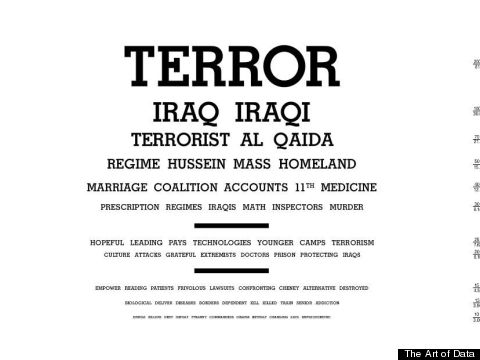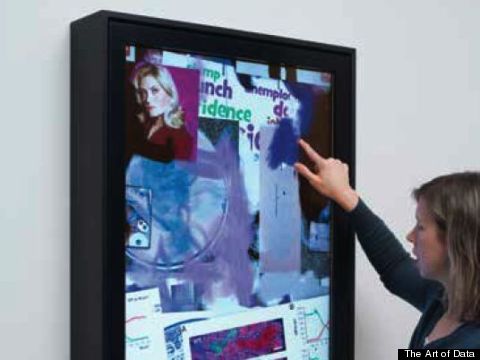As part of the Aspen Ideas Festival's design track, Peter Hirshberg explores the implications of Big Data--and how artists are vital in helping us understand and interpret this phenomena. The Art of Data exhibit is on view in The Resnick Gallery, lower floor of the Doerr-Hosier Center through September 2nd. It can be seen online at www.theartofdata.org. A panel discussion on the Art of Data with artists and curators will take place at 1:20 pm on July 1st in Doerr-Hosier Center.

This is the era of pervasive data: we are surrounded by signals and sensors that chronicle everything about our world and our lives. Web and mobile phone usage patterns reveal much about our behavior. Soon practically every device will be a connected device: our cars, fitness monitors, streetlights, and buildings will all participate in the data production economy. This represents a shift in the human condition, a shift in what it means to be human when everything about us can be quantified, measured, analyzed, and nearly permanently stored. All this creates unprecedented economic opportunity, but also new anxieties about privacy, identity and the nature of hyper-quantified humanity.
Enter the artist, who has always helped us see the world in new and different ways. New technologies have also reliably led to disruptive advances in art: think what perspective did for the renaissance or how the portable oil tube enabled the impressionists to move outdoors and paint in natural light. So consider what a moment this is for artists as they embrace a new medium: the world of data.
The Art of Data presents four artists who are pioneers in developing the visual language that makes data captivating, expressive and meaningful. They follow in the tradition of filmmakers, photographers and pop artists who embraced new technology throughout the 20h century, and explored the intersection of commercialism and art. These works take us beyond literal data visualization (a staple of science, business and journalism) to help us see the unexpected in data, gain a sense for its cultural meaning, and make the otherwise abstract into an emotional experience. They don't provide ready answers, but rather ask questions about how data is represented, interpreted and used in society.
R. Luke Dubois uses pervasive data the way pop artists like Andy Warhol or James Rosenquist obsessively manipulated the mass consumer imagery of their era. Coming from the world of commercial illustration they adapted the language of advertising and pop culture to fine art. Today, DuBois uses contemporary software techniques to change the context in which we see data, presenting it in a fresh, sometimes jarring perspective. He asks how data can be emotionally impactful at a time when we are surrounded by so much of it we are practically numbed out.

Dubois' work plays a context flipping game with data. Hindsight is Always 20/20 (2008) uses the familiar context of a Snellen eye chart to present something unexpected: a statistical analysis of the Presidential State of the Union Addresses. The result is the ability to see all-at-once the rhetoric and priorities of every American Presidency. A More Perfect Union (2011) downloaded 16.7 million profiles from dating sites to analyze the words single Americans use to identify themselves. By transposing the language of personal ads for cities on the familiar form of a map, we are presented with a voyeuristic geography of our desires. Hard Data (2011) is Dubois' experiment in using the emotional power of music to experience data. It's a string quartet composed from Iraq war causality statistics in the style of composers who wrote for war. The project is also an act of data journalism: the artist spent a year gathering information from multiple sources to create a comprehensive casualty data set not available from any government.
These artists express their ideas in computer code and algorithms, which then execute the work. This approach predates computer art. In the 1960s conceptual artist Sol Lewitt wrote out detailed instructions for his Wall Drawings, which others then (painstakingly) executed. His phrase "The idea becomes a machine that makes the art," is now the basis for a new generation of art. There is a direct line from Lewitt to early computer drawing languages like Logo to Processing, a popular open source language co-developed by Artist Casey Reas.
In Signal to Noise (2012) Reas has constructed a machine that worries about the evolution of television. Every second a frame of analog TV is deconstructed and used to seed a unique abstract digital response. It plays out the tension between old and new media relentlessly on screen.
Rafael Lozano-Hemmer's Zero Noon (2013) is an examination of the time dimension in data. At what rate do species go extinct, do we consume oil, or do girl scouts sell cookies? Each of these is rendered as a 24-hour clock giving us a visceral feel for the pace of these phenomena as well as an exotic new measure of time.
Siebren Versteeg applies the concept of collage to the Internet: In Light; of Everything uses custom software to collect images from everywhere and assembles them into a composition daily. Like Zero Noon, it starts fresh each day.
Fifty Years ago Aspen Institute founder Walter Papepke turned to artists and designers of the day like László Moholy-Nagy and Herbert Bayer to interpret the Great Ideas of Western Man at a time of cold war ideological tensions. Today, with big data and its implications so important to citizenship and society, artists are at the forefront of helping us see and understand data in altogether new ways. And the questions they ask help us process our collective anxiety and fascination with the phenomena of a pervasively instrumented world.

The art of data exhibit can be seen online here.